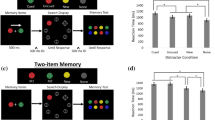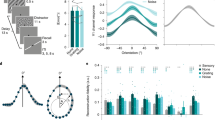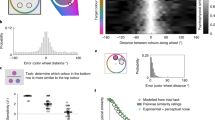Abstract
Short-term memory storage can be divided into separate subsystems for verbal information and visual information1, and recent studies have begun to delineate the neural substrates of these working-memory systems2,3,4,5,6. Although the verbal storage system has been well characterized, the storage capacity of visual working memory has not yet been established for simple, suprathreshold features or for conjunctions of features. Here we demonstrate that it is possible to retain information about only four colours or orientations in visual working memory at one time. However, it is also possible to retain both the colour and the orientation of four objects, indicating that visual working memory stores integrated objects rather than individual features. Indeed, objects defined by a conjunction of four features can be retained in working memory just as well as single-feature objects, allowing sixteen individual features to be retained when distributed across four objects. Thus, the capacity of visual working memory must be understood in terms of integrated objects rather than individual features, which places significant constraints on cognitive and neurobiological models of the temporary storage of visual information7.
This is a preview of subscription content, access via your institution
Access options
Subscribe to this journal
Receive 51 print issues and online access
$199.00 per year
only $3.90 per issue
Buy this article
- Purchase on Springer Link
- Instant access to full article PDF
Prices may be subject to local taxes which are calculated during checkout

Similar content being viewed by others
References
Baddeley, A. D. Working Memory(Clarendon, Oxford, (1986)).
Jonides, J. et al. Spatial working memory in humans as revealed by PET. Nature 363, 623–625 (1993).
Miller, E. K., Erickson, C. A. & Desimone, R. Neural mechanisms of visual working memory in prefrontal cortex of the macaque. J. Neurosci. 16, 5154–5167 (1996).
Wilson, F. A. W., O'Scalaidhe, S. P. & Goldman-Rakic, P. S. Dissociation of object and spatial processing domains in primate prefrontal cortex. Science 260, 1955–1958 (1993).
Paulesu, E., Frith, C. G. & Frackowiak, R. S. J. The neural correlates of the verbal component of working memory. Nature 362, 342–345 (1993).
Fuster, J. M. Memory in the Cerebral Cortex: An Empirical Approach to Neural Networks in the Human and Nonhuman Primate(MIT Press, Cambridge, MA, (1995)).
Lisman, J. E. & Idiart, M. A. P. Storage of 7+/−2 short-term memories in oscillatory subcycles. Science 267, 1512–1515 (1995).
Phillips, W. A. On the distinction between sensory storage and short-term visual memory. Percept. Psychophys. 16, 283–290 (1974).
Pahler, H. Familiarity and visual change detection. Percept. Psychophys. 44, 369–378 (1988).
Palmer, J. Attentional limits on the perception and memory of visual information. J. Exp. Psychol. Hum. Percept. Perform. 16, 332–350 (1990).
Green, D. M. Detection of auditory sinusoids of uncertain frequency. J. Acoust. Soc. Am. 33, 897–903 (1961).
Palmer, J. Set-size effects in visual search: the effect of attention is independent of the stimulus for simple tasks. Vision Res. 34, 1703–1721 (1994).
Palmer, J., Ames, C. T. & Lindsey, D. T. Measuring the effect of attention on simple visual search. J. Exp. Psychol. Hum. Percept. Perform. 19, 108–130 (1993).
Cohen, A. & Ivry, R. Illusory conjunctions inside and outside the focus of attention. J. Exp. Psychol. Hum. Percept. Perform. 15, 650–663 (1989).
Miller, G. A. The magical number seven, plus or minus two: Some limits on our capacity for processing information. Psychol. Rev. 63, 81–97 (1956).
Duncan, J. Selective attention and the organization of visual information. J. Exp. Psychol. Gen. 113, 501–517 (1984).
Treisman, A. The binding problem. Curr. Opin. Neurobiol. 6, 171–178 (1996).
Singer, W. & Gray, C. M. Visual feature integration and the temporal correlation hypothesis. Annu. Rev. Neurosci. 18, 555–586 (1995).
Niebur, E., Koch, C. & Rosin, C. An oscillation-based model for the neuronal basis of attention. Vision Res. 33, 2789–2802 (1993).
Luck, S. J. & Beach, N. J. in Visual Attention(ed. Wright, R.) (Oxford Univ. Press, in the press).
Sperling, G. The information available in brief visual presentations. Psychol. Monogr. 74((1960)).
Acknowledgements
This research was supported by grants from the McDonnell-Pew Program in Cognitive Neuroscience and the National Institute of Mental Health.
Author information
Authors and Affiliations
Corresponding author
Rights and permissions
About this article
Cite this article
Luck, S., Vogel, E. The capacity of visual working memory for features and conjunctions. Nature 390, 279–281 (1997). https://doi.org/10.1038/36846
Received:
Accepted:
Issue Date:
DOI: https://doi.org/10.1038/36846
Comments
By submitting a comment you agree to abide by our Terms and Community Guidelines. If you find something abusive or that does not comply with our terms or guidelines please flag it as inappropriate.



